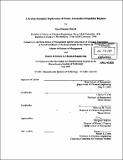A system dynamics exploration of future automotive propulsion regimes
Author(s)
Metcalf, Sara Susanne, 1974-
DownloadFull printable version (12.08Mb)
Other Contributors
Leaders for Manufacturing Program.
Advisor
Charles H. Fine and Jefferson W. Tester.
Terms of use
Metadata
Show full item recordAbstract
In the industrialized world, the automotive industry faces growing environmental regulation in the form of standards for local air pollutant emissions and fuel economy. Yet another target for regulation in the near future could be carbon dioxide, as its greenhouse gas behavior becomes increasingly linked to climate disturbances on a global scale. And as the automotive industry expands its operations to emerging markets with exponential population growth, the appropriateness of a crude oil-dependent internal combustion infrastructure may be called into question for reasons of fuel availability and price. Out of concern for these developments, some auto companies are working to make the automobile more sustainable. A major part of their efforts involves pursuit of alternative propulsion systems in parallel with the evolving internal combustion engine. In this thesis, I explore how propulsion regimes might shift in the near term (ten-year) future using a set of scenarios generated with a system dynamics model. Moreover, in this way I test the usefulness of the system dynamics methodology for scenario creation. While a variety of fuels can be used to power a given propulsion system, I limit this study to one fuel option per system. Four specific systems are considered: a gasoline internal combustion engine (ICE); a gasoline hybrid system that combines an ICE with an electric motor to conserve fuel; a battery electric vehicle (EV) charged regularly from the electricity grid; and a fuel cell electric vehicle (FCEV) that electrochemically converts hydrogen to electricity for propulsion. I first examine the motivation and method for exploring future propulsion regimes, and then provide a technology assessment of propulsion attributes on the basis of existing studies. Next is a description of how these attributes can feed a system dynamics model to explore how technology demand might evolve in consideration of the relative presence of infrastructure, availability, and awareness for each propulsion option. Using this model, a set of three scenarios is created by adjusting model parameters and providing supporting rationale. Finally, I discuss strategic implications both of the scenarios themselves and of insights gleaned through the system dynamics modeling exercise.
Description
Thesis (S.M.)--Massachusetts Institute of Technology, Sloan School of Management; and, (S.M.)--Massachusetts Institute of Technology, Dept. of Chemical Engineering; in conjunction with the Leaders for Manufacturing Program at MIT, 2001. Includes bibliographical references (p. 119-121).
Date issued
2001Department
Leaders for Manufacturing Program at MIT; Massachusetts Institute of Technology. Department of Chemical Engineering; Sloan School of ManagementPublisher
Massachusetts Institute of Technology
Keywords
Sloan School of Management., Chemical Engineering., Leaders for Manufacturing Program.